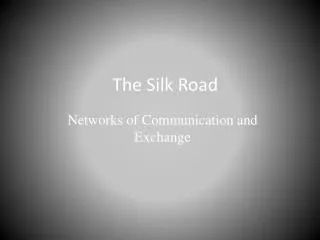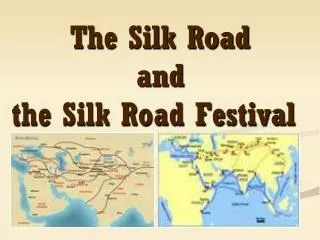The Silk Road
The Silk Road was an ancient network of trade routes that extended from Eastern Europe to China. The 4000-mile trade route dates back to the 2nd century B. In 1870, Ferdinand van Richthofen, a German geographer, named it “Silk Road†because silk was the most popular goods.
Share Presentation
Embed Code
Link

pandasilk + Follow
Download Presentation
The Silk Road
An Image/Link below is provided (as is) to download presentation Download Policy: Content on the Website is provided to you AS IS for your information and personal use and may not be sold / licensed / shared on other websites without getting consent from its author. Content is provided to you AS IS for your information and personal use only. Download presentation by click this link. While downloading, if for some reason you are not able to download a presentation, the publisher may have deleted the file from their server. During download, if you can't get a presentation, the file might be deleted by the publisher.
Presentation Transcript
- The Silk Trade
- Originating from Chang’an(the present-day Xi’an),the route traversed Shanxi Province,the hexi corridor in Gansu province ,the Tarim Basin in Xingjing,the Pamir mountain region ,Afghanistan,Iran, Iraq and Syria,ending at the eastern
- The ancient Silk Road in northwest China has a history of more than two thousand years. Originally, the Chinese traded silk internally within the empire. Caravans from the empire's interior would carry silk to the western edges of the region. They were often attacked by the small Central Asian tribes who wanted to capture the traders' valuable commodities. THE SILK ROAD
- In order to protect these caravans and assure the safety of the trade, the Han Government dispatched General ZhangQian as an envoy to build good relationships with these tribes. THE SILK ROAD
- (164BC~114BC) An explorer, traveler and diplomat in Han dynasty.
- Starting from Chang’an, today's Xi’an, which was the capital of the Western Han Dynasty, Zhang led his team across the vast Western Regions and reached Loulan, Guizi and Yutian states and established trade relations with these small kingdoms. THE SILK ROAD
- Loulan, Guizi and Yutian were three important states in the Western Region at that time. They were all abandoned for uncertain reasons and travelers today can see ruins of these three once flourishing places. THE SILK ROAD
- Zhang’s officers went even further into the central Asia. All of the kingdoms that Zhang and his team had visited sent their envoys to visit Chang’an (today’s Xi’an) to express their appreciation for the new relationship and show their respect to the Han Government. THE SILK ROAD
- From then on, merchants could travel on the silk route safely, and they began to explore this new route in order to carry silk from China to other parts of the world. THE SILK ROAD
- The famous Chinese Monk Xuanzang in Tang Dynasty traveled along the Silk Road during the Tang Dynasty. THE SILK ROAD
- The famous Chinese Monk Xuanzang in Tang Dynasty traveled along the Silk Road during the Tang Dynasty. Xuanzang began his trip from Chang’an (today's Xi’an) and passed through the GanSu Corridor, HaMi, TurPan and continued his journey westward to India. Xuanzang was surprised by the warm reception he received along his way. THE SILK ROAD
- It was commonly believed that people in those states were brutal, wild and uncontrollable. Xuangzang's trip changed the attitude toward the nomadic tribes in the Western Region and this contributed greatly to the Tang government's friendly relationship with these states. By 760 AD, the Tang Government had lost control of the Western Region and trade on the Silk Road was halted. THE SILK ROAD
- It revived tremendously under the Yuan Dynasty during the eleventh and twelfth centuries when China became largely dependent on its silk trade. Genghis Khan conquered all the small states, unified China and built a large empire under his rule. THE SILK ROAD
- Trade along the Silk Road reached its zenith during this period. The famous traveler Marco Polo traveled along the Silk Road visiting DaDu that is today's Beijing and wrote his famous book about the orient. THE SILK ROAD
- As overland trade became increasingly dangerous, and travel by sea became more popular, trade along the Silk Road declined. While the Chinese did maintain a silk-fur trade with the Russians north of the original Silk Route, by the end of the fourteenth century, trade and travel along the road had decreased significantly. THE SILK ROAD
- The Silk Road was definitely an important path for cultural, commercial and technological exchange between traders, merchants,pilgrim ,missionaries even soldiers. During more than 2000 years, the road improved the transfer from nomads to urban dwellers across the Asian continent even the countries bordering upon Mediterranean. THE SILK ROAD
- THE SILK ROAD The emergence of the Silk Road vigorously promoted the East-West economic, cultural exchanges, and contributed to the rise of the Han Dynasty. Further more, that route is a key pathway of Intercourse between East and West, either.
- As the road to the west was popularly known for its trade of silk, which was priced as valuable as gold, that commercial route came to be known as the Silk Road.
- Ⅱ.Routes of the Silk Road • Generally speaking , there were two major routes: one was overland, the other was across the Indian Ocean.
- The sea route of “Silk Road” normally starts from Guangxi or else port towns on the southeastern coast of China. A fleet extends its voyage through the sea of Japan, the Yellow Sea, South China Sea, the Bay of Bengal, around the Malay Peninsula, off the coast of Burma, and came to Southeast Asia and the India Peninsula. Then, it continues along a route across the Indian Ocean, the Arab Sea, the Persian Gulf, the Red sea and finally arrives at destination ports of Africa or Europe.
- Guangxi the sea of Japan the Bay of Bengal the India Peninsula the Persian Gulf
- With the development of seamanship and navigation, particularly after Zhenghe successfully sailed to the West, a sea route to the West took the place of the silk road overland.
- The silk road, which is mentioned today, refers exclusively to the overland route. The reason is simple: sea route mainly exported porcelain then silk, gunpowder, tea, imported species, pepper, cotton and other commodities.
- Ⅲ.The meaning of the Silk Road The Silk Road had served for tens of hundreds of years as the main route of business over the continents of Asia, Europe and Africa, an artery of Commodity Flow and cultural exchange that gave immense impetus to the rise of major economies and civilization of the world. It linked such ancient civilizations as China, India, Greece, Egypt, and Babylonia. In a sense, the Silk Road was no other than a route of culture and civilization.
- Silk garments is regarded as characteristic of the aristocratic and the genteel. As an important variety of the cloth world, under the influence of a “green revolution”, the trend of returning to nature, people find silk to be an ideal choice for its health-keeping properties of natural fiber.
- Reference: • https://en.wikipedia.org/wiki/Silk_Road • https://www.pandasilk.com/silk-road-facts/

The Silk Road
The Silk Road. Networks of Communication and Exchange. The Silk Road. The Silk Road was an important overland trade route which stretched more than 5,000 miles and linked China with the Mediterranean coast of the Middle East and Europe.(McCannon 82)
1.28k views • 17 slides

The Silk Road
The Silk Road. Chapter 7 – Networks of Communication and Exchange. The Silk Road. The Silk Road was an important overland trade route which stretched more than 5,000 miles and linked China with the Mediterranean coast of the Middle East and Europe.(McCannon 82)
504 views • 17 slides

The Silk Road
The Silk Road. SS.6.W.4.10 & SS.6.G.5.2. The Father of the Silk Road. A Chinese explorer named Zhang Qian is often called the Father of the Silk Road.
559 views • 8 slides

The Silk Road
The Silk Road. Ms. Taylor World History . A video opener…. http://youtu.be/LowP8zYHDYA. Definitions . “Silk Road" is shorthand for 1500 years of economic and cultural exchange across Eurasia One of the world’s oldest and most important trade routes
714 views • 21 slides

……..The Silk Road
……..The Silk Road . - it linked people from the east and west for more than 1000 years. The Silk Road opened under the Han Dynasty. Zhang Qian - was sent by the emperor Han to explore the Silk Road -he was sent with 100 men to form alliances w/western people against the Huns
384 views • 5 slides

The Silk Road
The Silk Road. 7 th Grade Early World History. What do you see, hear, and smell in this picture?. Learning Targets for the Silk Road. Describe how products and ideas were spread through the Silk Road Identify the Geographic locations and features of the Silk Road
1.76k views • 43 slides

THE SILK ROAD
THE SILK ROAD. The Silk Road . In order to make trade possible, began to develop what has been called in modern times, the silk road. Following this route merchant traders brought silk from China westward, and glass, linen, and gold from the West back into China.
619 views • 3 slides

The Silk Road
The Silk Road. Chapter 15, Section 2. The Silk Road. Reuniting and Expanding China First emperor encouraged learning, lowered taxes, and ended the harsh rules Expanded rule into central, north, and south Asia The Structure of Government Strong central government
165 views • 3 slides

The Silk Road
The Silk Road. The World’s First Internet. World’s First Internet.
250 views • 12 slides

The Silk Road
The Silk Road. Ancient China. The Silk Road. The Silk Road carried Chinese goods as far as Greece and Rome. Chinese and Arab merchants made lots of money doing this For centuries, Chinese goods were very desirable in the west The road was very expensive and difficult
247 views • 3 slides

The Silk Road
The Silk Road. “Information super highway of its age”. Key Points. One of the oldest and most historically important trade routes Linked the Roman Empire with China. Trade carried on by foreign traders Not common for traders to traverse the entire length. Rise of the Silk Road.
433 views • 14 slides

The Silk Road
The Silk Road. Global History I: Spiconardi & Roher. Geography of the Silk Road. Silk Road stretched from Xi’an, China to Rome It covers a vast area of different climates and geographies Taklimakan Desert Occupies much of the routes
1.76k views • 7 slides

The Silk Road
The Silk Road. Viewing the Silk Road from Space. The Silk Road stretches over 4,000 miles (6,500km) from Beijing, China to Rome, Italy. It was not actually a road. It was not paved. The Silk Road was a name given to any route which led from Beijing to Rome.
2.12k views • 21 slides

The Silk Road
The Silk Road. By Nate Strout. The Silk Road made China powerful. On the Silk Road Chinese merchants trade silk, porcelain, and jade for gold, silver, and gems. The Silk Road made China what it is today. Mongols and Merchants.
9.85k views • 6 slides

The Silk Road
The Silk Road. GPS SS7E9 The student will explain how voluntary trade benefits buyers and sellers in Southern and Eastern Asia. a. Explain how specialization encourages trade between countries.
1.21k views • 14 slides

The Silk Road and the Silk Road Festival
The Silk Road and the Silk Road Festival. Lesson for Fifth Grade Designed By: iyad aldakar. ((Motivating Question)). 1- What is the meaning of festival ? 2- Do you know the Silk Road Festival? 3- What can you see and hear in the Silk Road Festival?. Dear Students:.
741 views • 18 slides

The Silk Road
The Silk Road. This slideshow is designed to Illustrate the physiographic features at various points along the Silk Road(s).
487 views • 26 slides

The Silk Road and the Silk Road Festival
The Silk Road and the Silk Road Festival. Lesson for Fifth Grade Designed By: bashar Al-jarbou. ((Motivating Question)). 1- What is the meaning of festival ? 2- Do you know the Silk Road Festival? 3- What can you see and hear in the Silk Road Festival?. Dear Students:.
811 views • 18 slides

The Silk Road
The Silk Road. The Silk Road was one of the reasons the Han dynasty prospered with a network of smaller trade routes that stretched more than four thousand miles.
712 views • 9 slides

The Silk Road
The Silk Road. Friday, November 18 th , 2016. Warm Up: Predict: How do you think the Mongols and their empire impact trade?. Friday, November 18 th , 2016. Agenda: Vocabulary Item Trade Items & Value Challenges on the Silk Road Maps – Routes, Beliefs, Climate, Languages Quick write
610 views • 38 slides

The Silk Road Why “Silk”?
The Silk Road Why “Silk”?. China and the World. Silkworm cocoons on a Mulberry tree. The silkworm is a catapillar from a moth. This one is known as, “The silkworm of the Mulberry tree. Silkworm cocoons collected and being prepared for making silk. A Mulberry tree.
409 views • 9 slides























